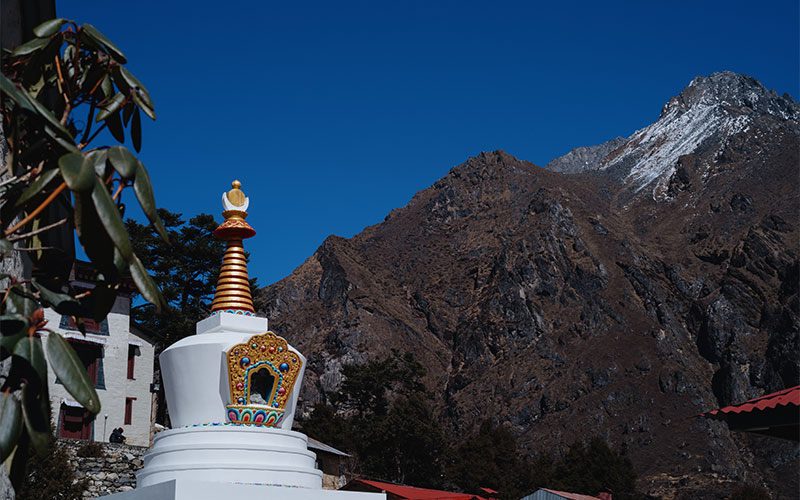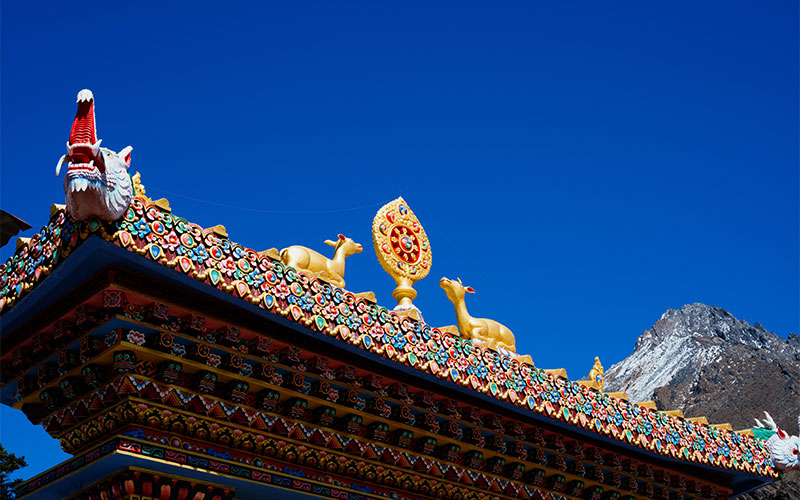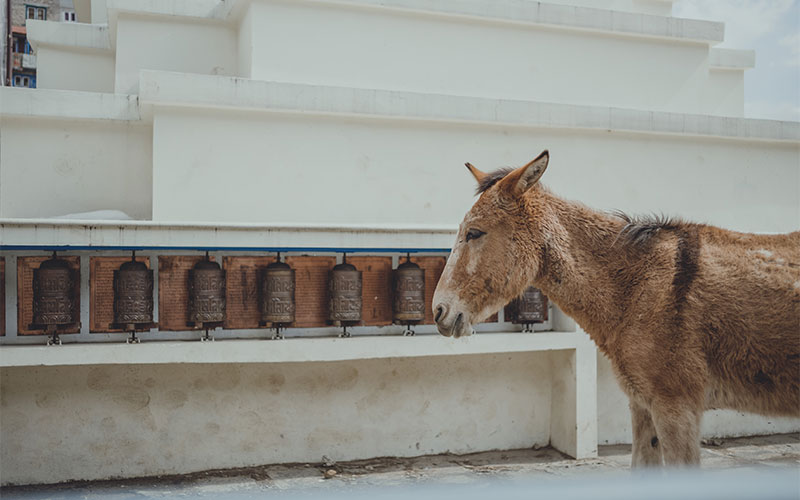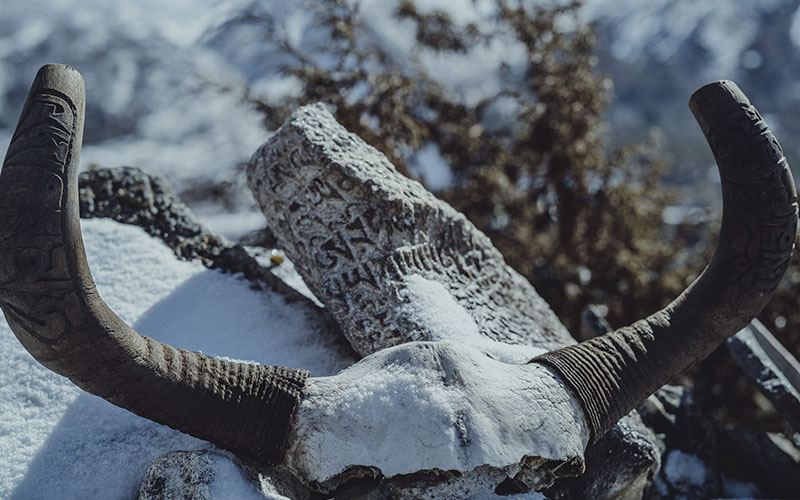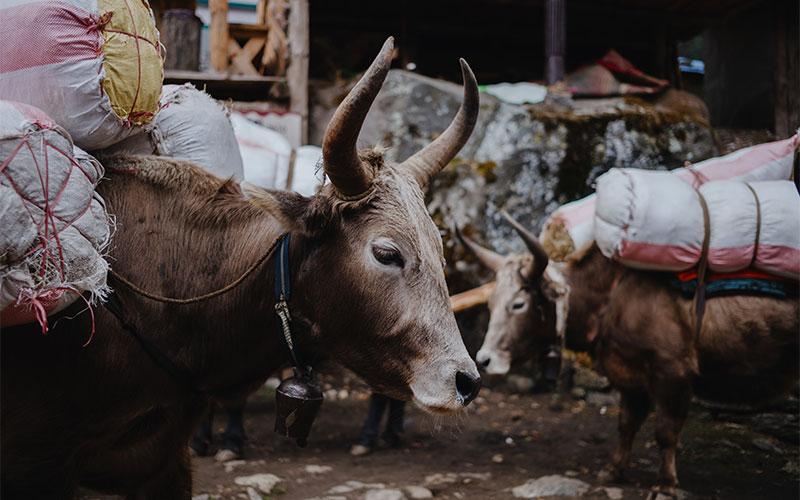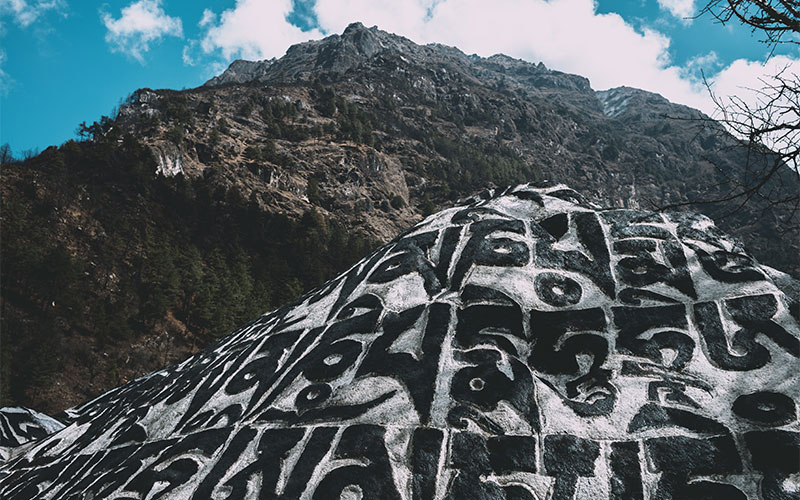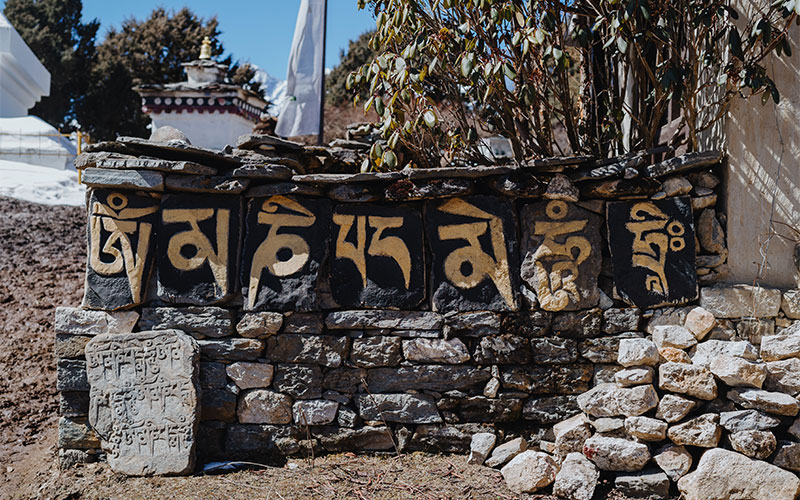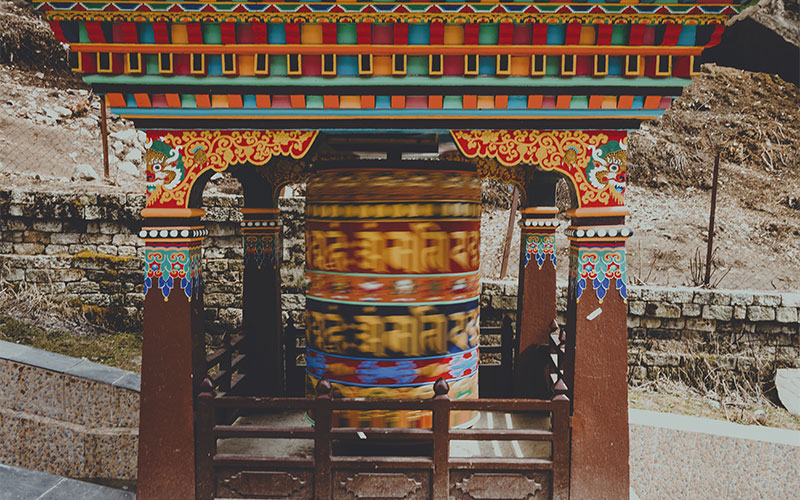Sam Gillilan's Himalayan Adventures with the Leica M-10D
A Documented Journey
Samuel Gillilan documented his journey of venturing into the Himalayas; discover his cultural exploration and dangers he faced along the path as well as the majesty of the Himalayan peaks through his incredible photographs.
On the morning of March 1, 2020, I awoke in my hotel at 4 AM in Kathmandu. With my 20L Peak Design bag packed with all of my worldly belonging, my Leica M10-D and two of my favourite lenses, the Summicron 35mm Asph, and the Summicron-APO 50mm packed in lovingly ready for the coming expedition. This has quickly become my favourite digital Leica M. I have used nearly every previous digital model of the Leica M, the M10-D brings a truly analogue with digital benefits, making seeing one’s film roll at the end of the day exciting and builds skill as a Leica M photographer.
The morning chanting had already begun in the temples nearby, the smell of incense filled the air, the sound of bells rang in my ears, and my neighbour loudly sang the sound of Om. These elements prepared my mind for the journey ahead. This day was special. I booked a sunrise flight with the Nepalese budget airline, Sita Air, from Kathmandu to Lukla, known as the most dangerous airport in the world for landing and take off. Thus began a deeply transformative trek to Mt. Everest Base Camp, a one hundred and fifty-mile journey there and back again.
As I arrived at the valley of giants at the Lukla airport, my inner and outer world began to shift. I met my amazing guide, Ramesh, in a local tea house. He was a short Nepalese man with a big smile and a humorous, playful spirit. Despite speaking very little English, he and I communicated as if we were old friends.
Leaving Lukla on a four-hour trek to Phakding, we passed small mountain villages, where people were spinning prayer wheels in their hands and chanting “Om Mani Padme Hum [ཨ"་མ་ཎི་པ་(ེ་*ྃ].” The environment was filled with gardens growing in the low lands near the glacial rivers; mules and yak carrying goods and supplies for the Sherpa people; homes and tea houses made of stone; and local dogs huddled together to stay warm. We arrived at the lodge in Phakding for the evening and I began to explore the area. I was in awe that for generations the local people hand-carved Tibetan mantras into massive rock formations; and placed stone tablets with prayer inscriptions near stupas on the path.
The next day, a real sense of mysticism sunk in. It felt like the mountains were speaking in ancient tones through wind, snow and stillness. Because of low oxygen levels at these high elevations, meditation, yogic breathing techniques, and willpower became a necessity for life and balance. I began to exclusively use the Summicron-APO to capture the mystical environment, the majority of images were shot at f/16, the magic this lens produces at fully open apertures is incredible for dream-like portraits, however, the mountains demanded the upmost detail, that detail can be produced by this same lens, stopping it down in the bright highlands to illustrate the contrast of snow and rock.
The Himalayan mountains towered on every side of the trail as we made our way up in elevation. This was the most physically demanding part of the trek. We hiked for six hours over steep inclines and crossed huge gulfs of glacial rivers on suspension bridges. We ascended the hill to the village of Namche Bazaar at 3440m (11,286ft). This was the first stop to acclimate my body for two days. In the morning, I felt the burdens of altitude sickness with a splitting headache; only to be cured by drinking copious amounts of tea and breathing deeply to regain oxygen levels. Ramesh told me this day was to be the first sights of Sagarmatha. The viewpoint for Sagarmatha was at the top of the hill from Namche, twenty minutes away from our lodge, and near a local museum that commemorates expeditions of the past. My heart rejoiced and spirits lifted tremendously from the morning’s hardships. The day was filled with clear skies and laughs, while hawks soared overhead. I felt a tremendous achievement to lay my own eyes upon Mt. Everest.
On the fourth day of trekking, I realized I made a grave mistake of forgetting trekking poles. A nice set of trekking poles can take up thirty percent of the hiking load, and act as handles when ascending steep inclines. A good friend called me the evening prior excitedly explaining his experience of a ten-day Vipassana meditation I had recommended. He had been to Mt. Everest Base Camp a few years ago and suggested I meet Pasang Temba Sherpa, who could provide the proper equipment for the journey ahead.
Pasang grew up in the local area of Khumjung, having guided thousands of people to Mt. Everest; he’s been a trekking guide nearly his entire life and has been part of the major documentary and scientific expeditions. We met at a local tea house with a strikingly awe-inspiring view of Ama Dablam and Mt. Everest. It was a serene moment of rest and laughter over the warmth of coffee and smells of incense burning in the local lodge. He shared stories of the challenges he experienced during these expeditions over the past four generations. Before continuing on the trail, he brought me a single trekking pole. This simple object became one of the greatest tools on my journey to Mt. Everest Base Camp.
Ramesh and I continued on for another six hours, crossing the valleys and climbing to Tengboche, which sits at 3860m (12,664ft) in elevation. Tengboche houses a Mahayana Buddhist monastery dedicated to Mahakala [ནག་པ.་ཆ0ན་པོ།], known as The Great Deity of Time that transmutes, cycles, and shifts all that it touches. Ramesh and I stopped for meditation within the cold walls of this monastery.
The monks began to chant rhythmic tones and mantras as if they were in trance. I closed my eyes and began to breathe, while twisting small prayer beads in my hands, in sync with the sounds. After the meditation, we walked to the local lodge to be turned away. They had no vacancy for the evening. The next possible lodging for the night was another three hours down an icy hill to Deboche. The sun was low on the horizon and snow began to fall on the trail.
Lines of yaks trudged up the hill, passing us with ringing bells on their necks, announcing their procession. When we arrived at the lodge, the first stars appeared as temperatures dropped to -20c. The fire inside the lodge emanated warmth and welcomed us to rest from the day’s tiring journey.
On the morning of the fifth day, the sun’s rays of golden hues greeted the landscape. The snow-covered valley of Deboche glowed from the early morning light reflected from the Himalayan mountain peaks. This part of the trail had a restful quality. We passed sweeping valleys and rivers, stones with Tibetan inscriptions, and homes with children playing outside while the sun shined its radiant glow on the snowy landscape. Ascending six hours to the next village Dingboche, we passed magnificent views of Ama Dablam, which in Nepalese means “mother’s necklace,” a tribute to the traditional necklaces worn by the local village women as a rite of passage into womanhood.
The village of Dingboche is seated in an ancient glacial valley, at 4410m (14,468ft) in elevation, and is very exposed to the elements with temperatures dropping to -25c at night. The trees began to fade into the lower elevations and were replaced by small, resilient juniper bushes that survive cold temperatures and provide food for the local yaks. The combination of hiking, the thin layer of oxygen, and the cold of the night was starting to wear my body down. During the next few evenings, sleeping became very difficult due to low oxygen levels in the environment. To prevent any chance of altitude sickness, I began practising Qi Gong at night and in the morning to regulate my energy and body temperature. This practice became essential as Ramesh and I climbed higher in elevation.
The next morning, we departed on a seven hour trek to the village of Lobuche. This took us through an expansive valley surrounded by vast mountain ranges and small, local vegetation. We crossed a memorial of those who died climbing to Mt. Everest. This place spoke of courage and spirit; prayer flags flying in the wind and the sound of silence all around. I came upon a small stupa made for a child, who was climbing with their family only a few years ago, and had perished from an avalanche. This was an emotional moment for me as the deep understanding of risk, adventure, and the unknown all came into focus at once, moving me to tears for those who had died along their journey to the tallest mountains on Earth.
After leaving the memorial, the snow began to fall rapidly decreasing the visibility to only 2m (6ft) in front of us. The path narrowed and turned extremely icy with a 100m (300ft) drop to our left. A fear of falling came into my mind, yet in that moment, the warmth of gratitude for those whom I love deeply in my life, washed over me. This gave me the strength and courage to push through the storm and arrive in Lobuche for the evening.
The small village of Lobuche is elevated at 4910m (16,108ft) and is settled at a glacial river that flows from the Khumbu Icefall near Mt. Everest Base Camp. While trekkers were arriving in Lobuche after a snowstorm passed, a helicopter rescued a hiker who was suffering altitude sickness. After catching a glimpse of the event, we headed into the local lodge for the evening. The lodge had a heart warming atmosphere filled with laughter, Nepali card games, great food and tea to warm the soul. Outside the full moon rose illuminating the landscape. The moon gave a monochrome quality to the Himalayan peaks nearby. It felt like I had arrived on a primordial version of Earth, or perhaps another world entirely.
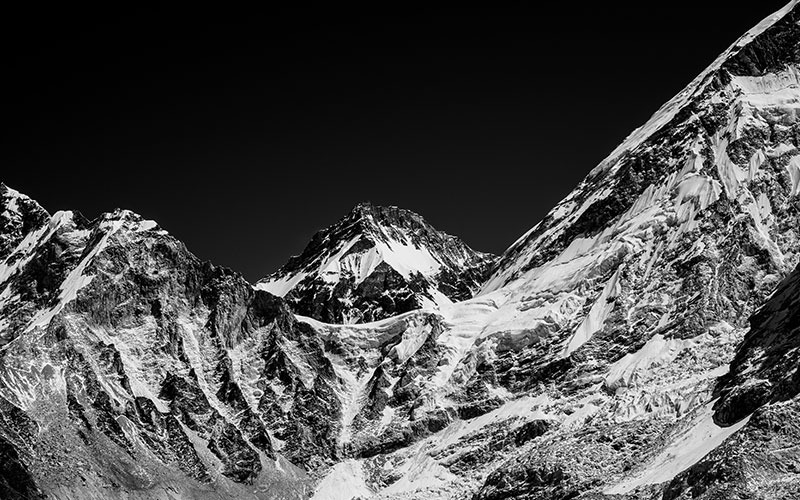 Leica M10-D // Ascent
Leica M10-D // Ascent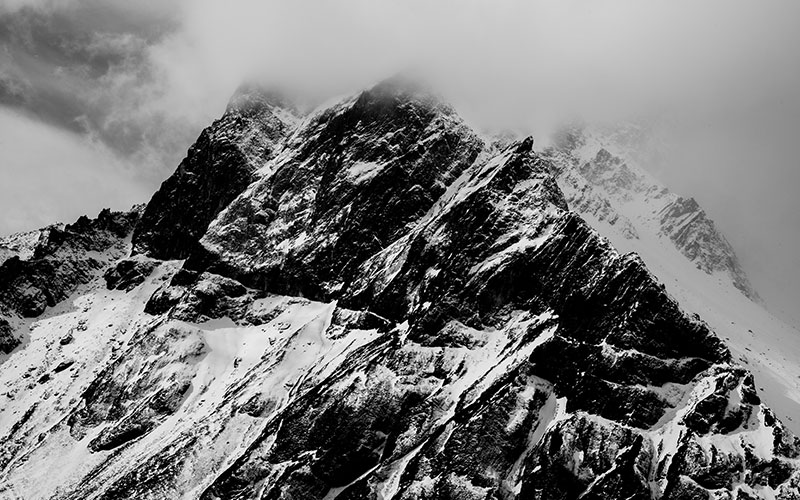 Leica M10-D // Breath
Leica M10-D // Breath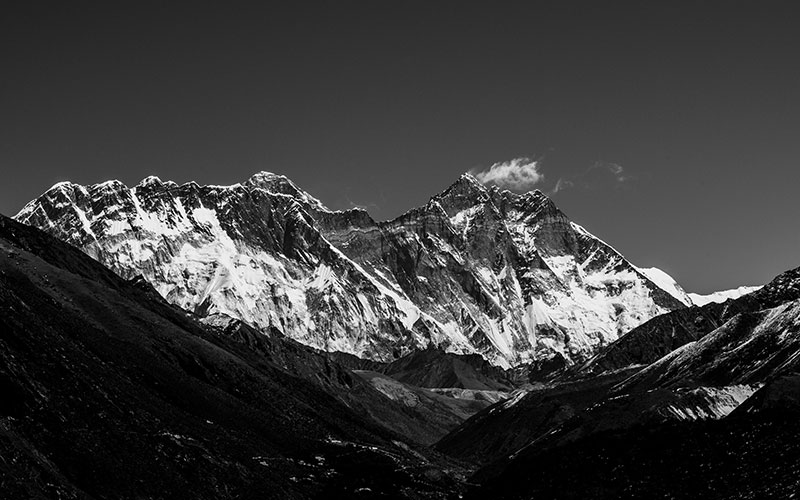 Leica M10-D // Crown
Leica M10-D // Crown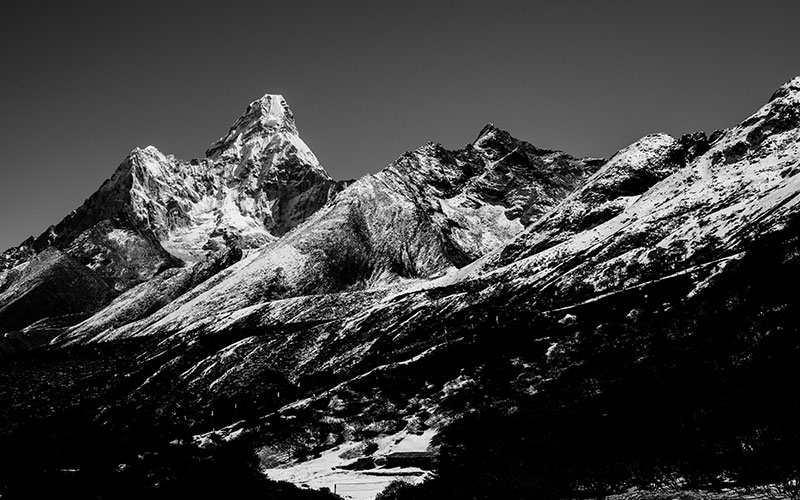 Leica M10-D // Union
Leica M10-D // Union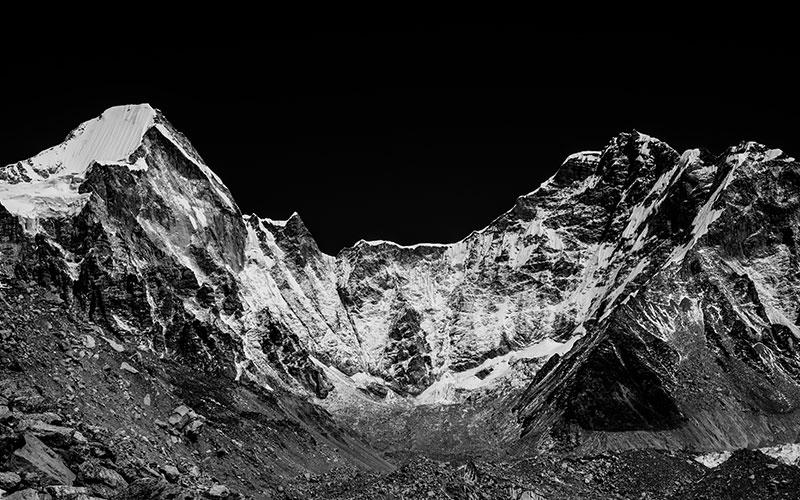 Leica M10-D // Wisdom
Leica M10-D // Wisdom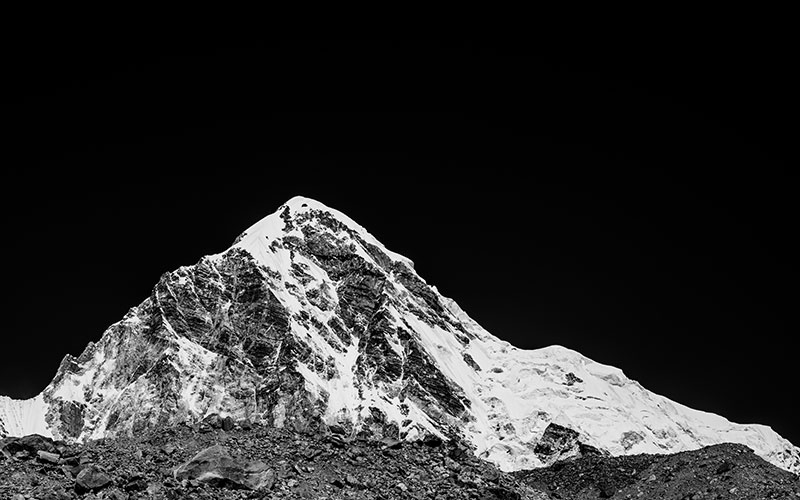 Leica M10-D // Zephyr
Leica M10-D // Zephyr
The next morning, we left Lobuche at 6am to Gorakshep, a four hour trek. The path took us over the glacial river formed by the Khumbu Icefall, a site of studies and expeditions over the years. The ice melt from this large glacial structure forms lakes and rivers at lower elevations providing water supply to Nepal and India. I could hear the river bubbling, just below the thick layer of ice, and the sound of my breath reaching for oxygen.
Although my head was pounding, willpower, breath, and Ramesh’s words of encouragement kept me focused on arriving to Gorakshep, the final outpost on the trek that provided lodging, goods, and helicopters. In 1952, this was the original Base Camp of Mt. Everest. The ancient lake bed that Gorakshep sits in, at 5160m (16,929ft), was surreal. This place felt familiar to me. It was the same valley that I had dreamt about many years ago on the island of Kaua’i. Following what the Dalai Lama dubbed “the steps to heaven,” I felt ecstatic to be arriving to Mt. Everest Base Camp today.
Ramesh and I traversed the long stretch of flatland, towards our final destination, for another hour around Kala Patthar with Nuptse and Lhotse summits to our right and only a sliver of Mt. Everest’s peak. Pumori’s peak reached into the sky. Just over the mountain range of Lho La was the plateau of Tibet. Finally, we had triumphed our ascension in the land of giants and legends, at 5360m (17,585ft). We made it. My childhood dreams of reaching the tallest mountain in the world had been accomplished. Along the journey, the Holy Himalayan mountains taught me life changing lessons of impermanence and unconditional love. As the mountains shifted with time so did my own heart. It was time to return home.
About the Author
Samuel R. J. Gillilan (b. 1989) is an award-winning international Leica M photographer, visionary artist, educator, explorer, and author. He spent his early years growing up on a sailboat in the Pacific Northwest. Visual arts and music were at the forefront of his home-based education. After gaining a degree and career within the live music industry for over 10 years, his attention turned towards the medium of photography as a form of expressing the human experience. Samuel is based on Kaua’i, Hawai’i. He has travelled as a pilgrim to over eighteen countries to document multicultural Holy Sites. These pilgrimages have inspired his self-mastery through the medium of photography; a medium he uses to convey inner visions and ancient symbolism of the human psyche. Ancient traditions, symbolism, time, and the greater nature of reality are themes that thread together Samuel’s imagery. In March 2020, Samuel Gillilan made a solo expedition to Mt. Everest Base Camp in the heart of Nepal to capture the legendary Himalayan mountains using his Leica M10-D. www.samuelgillilan.com
Thank you!
Thanks for taking the time to read Sam's story, we really do hope it's inspired you. If you would like to talk to us regarding a Leica purchase then please feel to get in touch with our team of experts.
We have a LiveChat option on our website and we can, of course, be contacted via our email, we're also on the end of the phone too! Read more on how to contact us here >
Want to write for us?
If you've got experience with producing content on photo, video and/or optics products or techniques then we would love to hear from you. Contact our blog editor, Fee, with a sample of your work at [email protected].
- By Fiona Chandler
- 4 Feb 2021




























































